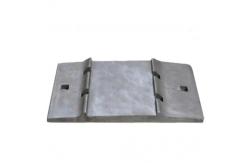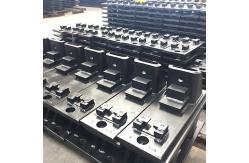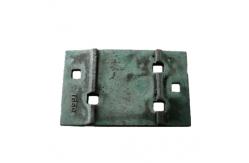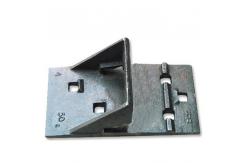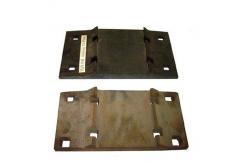Railroad Sleepers Fixing Tie Plate For Rail Onto Or Concrete Sleepers
|
|
Introduction of Railroad Sleepers Fixing Tie Plate Use For Rail Onto Or Concrete Sleepers A tie plate, baseplate or sole plate is a steel plate used on rail tracks between flanged T rail and the crossties. The tie plate increases bearing area and holds the rail to correct gauge. They are fastened to wooden ties by means of spikes or bolts through holes in the plate.
Material: Steel, Q235, Q345 Surface:Zinc Plated,Hot Dip Galvanized,Plain,Painted Coating, black Process: Drop forged,casting Color: Self Color,silver or others Some specification of casting material as below:
1. Production for Railroad Sleepers Fixing Tie Plate Use For Rail Onto Or Concrete Sleepers The railway cast iron backing plate is produced by the lost foam method, and is smelted in a 60kg intermediate frequency electric furnace. During the pouring process, the vacuum degree is maintained at 0.03 MPa, and the pouring temperature is 1580°C. Its chemical composition w is: 0.46%C, 0.23%Si, 0.59%Mn, 0.015%S, 0.024%P. After the casting is boxed, it is shot blasted and then annealed. The heat treatment process is: heating temperature 850℃; holding time 2h, cooling to room temperature with the furnace (total 12h). 2. Organizational analysis of the fracture of the iron pad OEM Hot Forging Forged casting Railway Tie Plate of Rail Fastening The body is sampled, and the as-cast and heat-treated castings are cut separately directly with a wire cutting machine, and the middle part is cut and prepared into several 10mm×15mm metallographic samples. Observe the metallographic structure with a metallographic microscope. It is the as-cast microstructure. It can be seen that the as-cast structure of the iron backing plate casting is ferrite + pearlite + Widmanstatite. Among them, the Widmanstatite structure is a continuous network, and a small amount of acicular Widmanstatten extends into the crystal grains. The research results show that when the carbon content of cast carbon steel exceeds 0.3%, the Widmanstatten structure will be produced when the grains are coarse. The main factors affecting the formation of Widmanstatten structure mainly include: austenite grain size, cooling rate and chemical composition. This Widmanstatten structure is brittle. Therefore, in order to improve the impact resistance of the backing plate casting, it must be eliminated by normalizing or annealing heat treatment. The factory originally used annealing heat treatment, which is the microstructure of the backing plate castings after annealing treatment, and there is a large amount of lath-shaped Widmanstatite. It can be judged that the annealing treatment did not eliminate a large amount of lath-shaped Widmanstatite. As a result, the existence of a large amount of lath-shaped Widmanite caused the backing plate castings to break when subjected to impact after being annealed. After careful inspection of the annealing equipment, it was found that the sealing performance of the annealing furnace door was poor, and the temperature control instrument of the annealing furnace had been damaged. Process requirements. 3. Improvement of iron pad production process OEM Hot Forging Forged casting Railway Tie Plate of Rail Fastening Based on the above analysis results, improvement measures are proposed: re-repair the annealing equipment, improve the sealing performance of the annealing furnace door, and ensure that the temperature in the furnace meets the process requirements. After rectification, the original annealing process is still implemented, and the unqualified castings are re-heated. After metallographic inspection, it is found that the iron pad castings after annealing treatment no longer have a large amount of lath-like Widmanstatite. The impact test results show that there is no longer any quality problem that is prone to fracture when subjected to impact. Due to the simple structure of the piece, in order to simplify the process, shorten the production cycle, improve production efficiency, and reduce costs, according to the shape and structural characteristics of the casting, the normalizing process is adopted. The specifications are as follows: heating temperature 850 ℃; holding time 1h, air cooling to room temperature . After the factory adopted the normalizing process, the iron backing plate castings did not break under the same impact. The production cycle is shortened, the production efficiency is improved, and the cost is reduced.
Kingrail is specilized in supplying various tie plates to suit UIC,54kg,60kg,RE115-119,RE132-136,BS75A,80A,90A100A Steel rails, etc. Other products supplied by Kingrail:
Rail car spares: wheels, axles, bearings, gears, couplers, etc Railway Track materials: Tie plates, fishplates, screw spikes, bolts and nuts, steel rails and accessories, joint bar, gauge rod, etc
1. Railway Fishplate / Joint Bar/ Splice Bar 3) Process: Forging,Casting,Rolled. To TJ45; TJ57 splice bar supporting South America standard fishtail bolt. Railway bolts: T bolt, HS26, HS32 series T bolt, turnout, hex bolt,
Subway bolts.
|
||||||||||||||||||||||||||||||||||||||||||||||||
| Product Tags: Railroad Sleepers Fixing Tie Plate Concrete Sleepers Fixing Tie Plate |
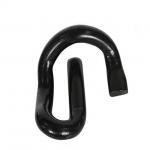
|
60 Si2mn Elastic Rail Clip 55Si2Mn Material OEM ODM Black Color |
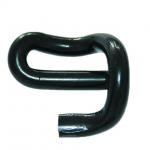
|
Elastic Railroad Rail Clips Kingrail OEM ODM Oxide Black Surface |
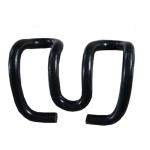
|
Railroad Elastic Rail Clips E Type W Type 47HRC 42HRC Hardness 55Si2Mn Material |
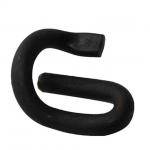
|
60Si2CrA Material Railroad E Clips , 44HRC Erc Rail Clip DIN 17221 |
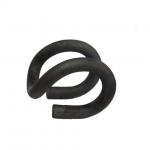
|
O Type Elastic Rail Clip 20mm 18mm 16mm Diameter For Railway |
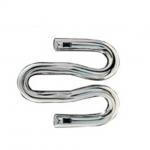
|
0.78kg Railway Track Clips , Erc Rail Clip SGS Standard Kingrail ODM |

